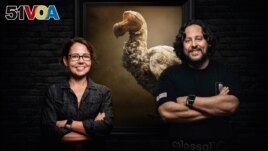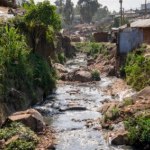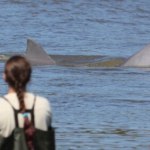05 February 2023
More investors are supporting a biotechnology company working on ways to bring back animals that have died off.
Some scientists, however, are doubtful such research efforts are possible — or even a good idea.
Colossal Biosciences first announced its plan to bring back a hairy ancestor of today's elephants, known as the woolly mammoth, two years ago. Recently, the company said it wanted to bring back the dodo bird: a large, flightless bird.

Dr. Beth Shapiro, Lead Paleogeneticist, and Ben Lamm, Colossal Co-Founder and CEO. (Image courtesy of Colossal Biosciences)
"The dodo is a symbol of man-made extinction," said Ben Lamm of Colossal Biosciences. The company has formed a special group that works on bird-related genetic technologies.
The last dodo was killed in 1681 on the Indian Ocean island of Mauritius.
Colossal Biosciences is based in the city of Dallas, Texas. It started operations in 2021. Recently, the company announced it had raised an additional $150 million in financing. To date, it has raised $225 million from many investors that include United States Innovative Technology Fund, Breyer Capital and In-Q-Tel, an organization supporting national security agencies.
The possibility of bringing the dodo back is not expected to directly make money, said Lamm. But the genetic tools and equipment that the company develops to try to do it may have other uses, including for human health care, he said.
For example, Colossal Biosciences is now testing tools to change several parts of the genome at the same time. It is also working on technologies for what is sometimes called an "artificial womb," he said.
The dodo's closest living relative is the Nicobar pigeon, said Beth Shapiro, a scientific advisor with the bioscience company.
She has been studying the dodo for 20 years. She is a professor at the University of California, Santa Cruz and receives financial support from the Howard Hughes Medical Institute (HHMI). The organization also supports The Associated Press' Health and Science Department.
Shapiro's team plans to study DNA differences between the Nicobar pigeon and the dodo to understand "what are the genes that really make a dodo a dodo," she said.
The team may then attempt to change Nicobar pigeon cells to make them seem like dodo cells. It may be possible to put the changed cells into developing eggs of other birds, such as pigeons or chickens. Then the birds might create young that could naturally produce dodo eggs, said Shapiro. The idea is not yet fully developed.
Shapiro said animals are a product of both their genetics and their environment — which has changed a lot since the 1600s. She added, "it's not possible to recreate a 100% identical copy of something that's gone."
Other scientists wonder if it is even a good idea to attempt to recreate species that have died off. They question whether such efforts take attention and money away from attempts to save living species.
There is a real risk "in saying that if we destroy nature, we can just put it back together again — because we can't," said Duke University's Stuart Pimm, who has no connection with the company.
"And where on Earth would you put a woolly mammoth, other than in a cage?" Pimm said. He also said that the environment where mammoths lived disappeared long ago.
Biologists who know about captive breeding programs say that it can be difficult for zoo-bred animals to live in the wild.
Boris Worm is a biologist with the University of Dalhousie in Halifax, Nova Scotia. He is also not linked to Colossal Biosciences.
He said animals need to learn from other wild animals of their kind — something that dodos and mammoths would not be able to do.
"Preventing species from going extinct in the first place should be our priority, and in most cases, it's a lot cheaper," he said.
I'm John Russell.
Christina Larson reported on this story for the Associated Press. John Russell adapted it for VOA Learning English.
Words in This Story
dodo bird – n. a kind of bird that lived in the past and that was large, heavy, and unable to fly
symbol –n. an object or sign that represents an idea or that stands for something else
extinction – n. the state or situation that results when something (such as a plant or animal species) has died out completely
genome – n. the complete set of genes and genetic material in an organism
womb – n. the organ in women and some female animals in which babies develop before birth
species –n. (also pl.) a group of animals or plants that are similar and can produce offspring of the same kind
captive breeding –n. the activity of keeping animals so they produce more young in a zoo or a place where they are not in natural conditions but in controlled ones
cheaper –comparative adj. less costly than something else












